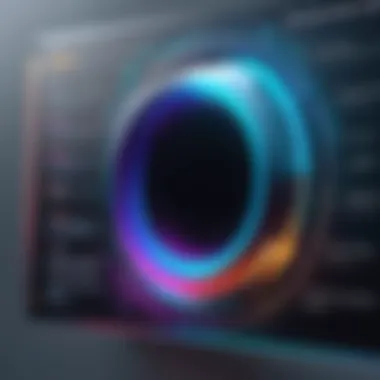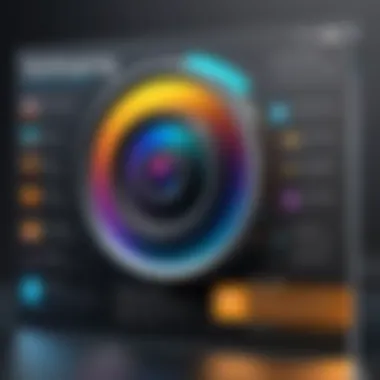Mastering Image Layering Techniques for All Users


Intro
Layering images is a powerful technique frequently used in graphic design, photography, and digital art. It offers a method to enhance visual storytelling, allowing creators to combine elements into a singular, cohesive image. This guide aims to provide a detailed exploration of various methods to layer images effectively, catering to both novices and experienced users alike.
Understanding image layering is essential for anyone involved in creative digital projects. Whether you are a casual user looking to edit your photos or a professional designer engaged in complex multimedia content, mastering this technique can significantly elevate the quality of your work.
Overview of the Technology
Image layering techniques span across multiple software platforms, including Adobe Photoshop, GIMP, and online tools like Canva. Each of these platforms contains unique features that cater to different skill levels and project requirements.
Key specifications
- Adobe Photoshop: This software is a robust tool that supports various layers, blending modes, and filters. Its versatility makes it a leading choice among professionals.
- GIMP: As an open-source alternative, GIMP is packed with powerful features similar to Photoshop but available at no cost. It is suitable for users who prefer budget-friendly options.
- Canva: An accessible, web-based tool ideal for beginners. It offers drag-and-drop capabilities that simplify the layering process, yet it still provides sufficient tools for more intricate work.
Unique selling points
- Photoshop empowers users with extensive customization options, perfect for detailed edits.
- GIMP allows creative expression without financial investment, appealing to hobbyists and those just starting.
- Canva provides a user-friendly interface, making it easy for anyone to start layering images almost immediately.
Techniques for Layering Images
Layering images involves various methods, each with different outcomes and usability. Below are some of the commonly employed techniques:
- Basic Layering: This method involves stacking images directly on top of each other in software like Photoshop or GIMP. Users can adjust each layer's opacity, creating a semi-transparent view of what's below.
- Masking: Using layer masks enables selective hiding of portions of a layer, which creates a more refined integration between multiple images. This technique is widely used in professional settings.
- Blending Modes: Different blending modes allow layers to interact in unique ways, affecting the overall look of the image. Photoshop offers numerous blending options that can alter colors and textures, providing endless creative possibilities.
- Adjustment Layers: These layers modify the impact of color and tones without altering the underlying image data. This is particularly useful for enhancing the overall aesthetic without destructive editing.
Culmination
By employing these techniques, users can unlock new potentials in their creative projects, achieving outcomes that can impress even discerning audiences. Whether you are editing a simple photograph or designing a complex visual narrative, understanding image layering provides a solid foundation for further exploration in digital art.
Understanding Image Layering
In the realm of digital design, the concept of image layering stands as a critical skill for both novices and experts. Mastering this technique not only enhances creative expression but also elevates the professional quality of visual content. Understanding image layering involves grasping how to combine images, manipulate their orientations, and engage with the various attributes that each layer can possess. This section aims to illuminate the foundational aspects of image layering, emphasizing its significance and diverse applications.
Definition of Image Layering
Image layering is simply the process of placing one image over another. Each image can be seen as a separate layer, allowing for individual manipulation of characteristics like opacity, filter effects, and blending options. Layers allow for complex visual compositions that would be difficult, if not impossible, to achieve with a single image. Each layer is independent, which means it can be edited without affecting the others. This modular approach allows designers to experiment and iterate with a greater degree of flexibility.
Importance in Digital Design
In digital design, the ability to overlay images plays a crucial role. It is vital for creating depth and interest in designs. Layering can enhance storytelling within a project, allowing for multiple elements to co-exist and interact in a visually appealing manner. Consider a promotional poster: layering text, images, and graphics in a harmonious way can convey a message more effectively than any single image alone. The blend of various elements can guide the viewer’s attention, making the design more impactful.
Applications Across Different Fields
The versatility of image layering finds applications across numerous fields. In advertising, it helps brands create stunning images that can attract attention and convey a message efficiently. In web development, layered images enhance user interfaces, making them more interactive and engaging. Furthermore, in fields like film, layering is integral for visual effects, combining live-action with CGI elements. Here are some specific areas where image layering is vital:
- Graphic Design: Artists utilize layering for creating logos, posters, and other visual assets.
- Photography: Photographers often layer images during editing to improve overall compositions and enhance effects such as reflections or depth of field.
- Web Design: Creators employ layering for enhancing user experiences through dynamic visuals.
- Gaming: Developers layer images to build immersive environments and complex characters.
Image layering is more than a technique; it is a powerful tool that enables creative professionals to push the boundaries of their craft. Understanding its principles is the first step toward mastering a vital aspect of digital design.
Choosing the Right Software
Choosing the appropriate software for layering images is crucial to achieving desired results. Different software applications offer distinct advantages that cater to various skill levels, purposes, and design needs. For beginners, user-friendly interface is essential, while advanced users may seek greater control and complex features. The selection of software ultimately affects the quality of the final image, the ease of use, and the speed of the workflow. Understanding the strengths and weaknesses of each option is vital for anyone looking to enhance their image editing capabilities.
Popular Image Editing Software
Adobe Photoshop
Adobe Photoshop is often seen as the gold standard in image editing. Its robust layering system allows for intricate designs and detailed adjustments. A key characteristic of Photoshop is its versatility, making it a popular choice among professionals and enthusiasts alike. One unique feature is the extensive library of brushes and tools, which enable artists to create effects that can be hard to achieve in other software. However, Photoshop can have a steep learning curve for new users, which may deter some beginners.
GIMP
GIMP, or GNU Image Manipulation Program, is an open-source alternative to commercial software like Photoshop. It is widely praised for its extensive features and flexibility, offering various tools for advanced editing. A notable aspect of GIMP is its zero cost, making it an attractive option for users on a budget. While it includes powerful functionality, some find the interface less intuitive compared to other software, potentially hindering its usability for those unfamiliar with image editing.
CorelDRAW
CorelDRAW is particularly famous for vector graphics, but it also has capabilities for image layering and editing. Its user-friendly interface is conducive to beginners, while still offering features that meet professional needs. One key aspect of CorelDRAW is the seamless integration with Corel’s other graphic design tools. This makes it advantageous for users who require a comprehensive suite for design projects. However, the software is generally more expensive than some alternatives, which may be a limiting factor for some potential users.
Affinity Photo
Affinity Photo stands out for its one-time purchase model, contrasting with subscription-based services like Photoshop. It combines powerful features such as advanced layer handling and editing tools. One unique feature is the ability to work with a plethora of file formats without worrying about compatibility. Affinity Photo has a learning curve, yet many users find its performance and features comparable to more established software at a more accessible price point.


Web-Based Tools for Simple Layering
Canva
Canva shines in its simplicity and accessibility. This web-based tool allows users to create layered images without extensive knowledge of graphic design. A principal characteristic of Canva is its drag-and-drop interface, which makes it easy for beginners to start layering images quickly. The wide range of templates and graphics available is a distinct advantage, enabling users to achieve professional-looking results with minimal effort. However, for intricate designs, Canva may not offer the depth found in more advanced software.
Fotor
Fotor offers a good balance between simplicity and capability. It provides online tools that allow users to layer images effortlessly, making it suitable for quick edits. A key feature is its batch processing, which allows users to edit multiple images at once. This is particularly useful for social media managers and small businesses. Nevertheless, Fotor's capabilities might not meet the needs of professional graphic designers seeking more detailed tools.
Pixlr
Pixlr is another strong option for online editing. It presents a tidy interface with essential features for layering images. The key characteristic of Pixlr is its efficiency, allowing fast edits through a web browser without sacrificing quality. Users appreciate the range of filters and effects available for enhancing images. On the downside, heavy reliance on internet connectivity can hinder performance, particularly when working with larger files.
Coding Solutions for Advanced Users
HTML/CSS
HTML and CSS are foundational technologies for web development. While not software in the traditional sense, they provide powerful methods for layering images on web pages. A significant aspect is their flexibility and control over layout and design. Developers can manipulate the z-index to stack elements in desired order. However, this approach may not be intuitive for those without programming experience, making it less accessible for non-coders.
JavaScript Libraries
JavaScript libraries, such as Fabric.js and Konva, enhance image manipulation capabilities in web applications. They allow programmers to create dynamic, interactive designs with layered images. A key characteristic is the functionality to manipulate images in real time, providing an engaging user experience. However, this requires a certain level of coding expertise, which can be a barrier for beginners.
"Choosing the right software is a decisive step toward effective image layering. Each option presents unique capabilities that cater to varied needs."
Basic Method: Layering Images in Most Software
Layering images is a fundamental technique in digital design that allows creators to combine visual elements seamlessly. Mastering the basic method of image layering is essential for anyone working in graphics, marketing, or social media. This section outlines the critical steps and skills associated with layering images using common software tools.
Through layering, you can create dynamic visuals that convey deeper messages or simply enhance the aesthetics of an image. Understanding the techniques of importing images, adjusting their sizes, and positioning layers is indispensable for both novice and experienced users. These steps not only improve the overall appearance of a design but also help communicate an idea more efficiently.
Importing Images
Importing images is the very first step in the layering process. This action involves bringing external images into your software of choice, whether it is Adobe Photoshop, GIMP, or another platform. Importing can vary slightly depending on the program, but the general process remains consistent.
- Open Your Software: Launch the image editing software. Make sure you have a new project or canvas open.
- Select Import Option: Locate the import option. In most cases, this can be found in the 'File' menu as 'Open' or 'Import'.
- Browse for the Image: Navigate through your files to find the images you want to layer. Select the desired image and confirm the import.
Importing is crucial because it sets the foundation for layering multiple images and ensures that you have the content necessary to create your desired composition. Also, ensure that the images you are importing are of sufficient quality to prevent loss of detail when layered.
Adjusting Image Sizes
Once images are imported, it is imperative to adjust their sizes properly. Understanding how to resize images correctly helps maintain proportion and clarity, ultimately impacting the visual output.
- Select the Layer: Click on the image layer you want to adjust. Most software allows you to select layers easily from a sidebar or directly on the canvas.
- Utilize Transform Tools: Use the transform or resize tool available in your software. You can typically access this by right-clicking the image or through a dedicated tool in the toolbar.
- Maintain Aspect Ratio: When resizing an image, it is essential to maintain the aspect ratio to avoid distortion. This can usually be done by holding the Shift key while dragging the corners of the image.
Properly adjusted image sizes allow for better integration within layered compositions. This ensures that each element complements others rather than competing for attention.
Positioning Layers
The final step in the basic method of layering images is understanding how to position them effectively. Layer positioning can transform a flat composition into a rich visual experience.
- Arrange the Layers: Depending on your software, layers can usually be moved up and down in a layer panel. The layer's order determines which images are on top and which are underneath.
- Drag and Drop: Use your mouse or trackpad to drag images into the desired position on the canvas. Ensure that overlapping parts work cohesively to create a harmonious design.
- Fine-Tuning Positions: Precision is key. Use arrow keys for finer movements if necessary, or input specific position values if your software allows for this.
Positioning layers allows for the creation of depth and focus within a design. This ability to control visibility and interaction between layers is what makes a layered image compelling and visually engaging.
"Layering is not just about stacking pictures; it is an art of balance and coherence."
To conclude, mastering the basic method of layering images equips users with essential skills. Proper techniques for importing, resizing, and positioning images will lead to enhanced visual storytelling, regardless of the platform used.
Advanced Techniques for Professionals
In the realm of image layering, advanced techniques separate proficient users from novices. These methods enable professionals to achieve greater precision and creativity in their design processes. Understanding advanced techniques such as layer masks, blending modes, and composite image creation expands the range of possibilities. Such skills are not only essential for producing high-quality images but also for streamlining workflows in complex projects. Professionals can manipulate images more effectively, ensuring that the final output conveys the desired message or aesthetic.
Layer Masks and Blending Modes
Layer masks are a powerful tool in image editing. They allow users to control which parts of a layer are visible or hidden. This is particularly useful for seamlessly blending multiple images. A layer mask adds a new dimension to the artwork by enabling non-destructive editing. Instead of permanently altering an image, users can simply paint on the mask with black to hide and white to reveal sections of the layer. This flexibility is key in professional design, as it allows for fine-tuning without losing original data.
Blending modes work hand in hand with layer masks. They determine how a layer interacts with the layers beneath it. For example, using the "Multiply" mode darkens the image, while "Screen" brightens it. Mastering these modes opens up creative avenues, helping designers create unique visual effects. Understanding the implications of each blending mode enhances the ability to achieve specific results, crucial for professional work.
Using Adjustment Layers


Adjustment layers give professionals enhanced control over image modifications. Unlike regular edits that adjust the image directly, adjustment layers allow changes without destroying the original image. This principle of non-destructive editing is vital in professional setups where revisions are frequent.
Common adjustments include brightness, contrast, saturation, and color balance. Each one can be applied while allowing real-time tweaking. For instance, if the colors are not quite right, the adjustment can be altered without needing to redo the entire piece. This technique significantly saves time and improves productivity. Additionally, professionals can organize these layers easily, making future modifications straightforward.
Creating Composite Images
Composite images combine elements from several sources. This technique is widely used in advertising, digital art, and other creative fields. Professionals often create composite images to produce visuals that convey specific narratives or messages that single images cannot.
To create a composite image, one must select the right subjects and backgrounds, ensuring they work well together visually. Layering appropriately and utilizing masks help blend images seamlessly. Shadows and lighting adjustments further enhance realism, making the final output appear cohesive. Essentially, the mastery of composite images is a hallmark of advanced image layering skills.
"The ability to create striking images often lies in the details of layering and blending. Mastery takes practice, but the results can elevate any project immensely."
Completing advanced layering techniques significantly enriches the designer’s toolkit, allowing for experimentation and creative exploration. These skills not only enhance professional output but also lead to improved workflow efficiency.
Techniques in Specific Software
When it comes to layering images, the software you choose plays a crucial role in determining the flexibility and output of your projects. Each application has its own unique features, advantages, and limitations. Understanding these elements is essential, especially for tech-savvy individuals looking to refine their skills.
Using specific software allows the user to harness powerful tools tailored for image manipulation. Different platforms cater to various user needs, from beginners interested in straightforward layering to advanced users seeking intricate editing capabilities. Knowledge of these tools can elevate your design process and improve overall efficiency.
Layering in Adobe Photoshop
Adobe Photoshop is widely recognized as the industry standard for image editing. Its sophisticated functions make layering images intuitive and versatile. Users can easily manipulate multiple layers with a wide array of options.
To start layering, you will typically import your images into the workspace. From there, you can use the Layers panel to control the visibility and arrangement of each layer. This feature enables creative freedom, allowing you to experiment without altering the original files.
Key features include:
- Layer Styles: Apply effects such as shadows, glows, or strokes for enhanced aesthetics.
- Adjustment Layers: Modify colors, brightness, and contrast without permanently changing the original image.
- Smart Objects: Maintain image quality even when resizing layers multiple times.
One drawback to consider is its subscription-based pricing model. While many professionals find value in the investment, those on a tight budget may seek alternatives.
Layering in GIMP
GIMP is another option favored by many, particularly due to its open-source nature and zero cost. It offers robust image manipulation features that rival those of Adobe Photoshop. The learning curve is somewhat steep compared to simpler tools, but for those willing to invest time, it yields powerful results.
Layering in GIMP involves similar steps to Photoshop. Import images and manage them in the Layers panel. The software features various selection and transformation tools to adjust layers effectively.
Key highlights include:
- File Compatibility: A supports a wide array of image formats, making it versatile for multiple projects.
- Customizable Interface: Users can personalize their workspace, boosting productivity.
- Extensive Plugins: Access additional features through numerous community-created plugins.
While GIMP is more accessible, some users may find its interface less intuitive, especially if they have mainly used proprietary software before.
Layering in Fotor
Fotor offers an online-based solution for those who prefer a simpler approach to image layering. It's user-friendly, making it an excellent choice for beginners or those in need of quick edits without extensive knowledge of complex software.
The layering process in Fotor is straightforward. Once images are uploaded, you can arrange them quickly on the canvas. Effects and adjustments are easily accessible, and the drag-and-drop functionality simplifies positioning layers.
Important points about Fotor include:
- Accessibility: Requires no installation, as it operates directly in the browser.
- Template Options: Includes various templates to help users start their projects easily.
- Limited Advanced Features: It may not satisfy the needs of professionals seeking more in-depth manipulation options.
Overall, while each software solution has its strengths and weaknesses, choosing the right tool will depend on your specific needs and level of comfort with image editing. Familiarizing yourself with these tools enhances your design capabilities and fosters creativity.
Best Practices for Layering Images
Understanding best practices in layering images is vital for achieving high-quality visual compositions. Following these guidelines can enhance not only the final appearance of a project but also the efficiency of the workflow. The effectiveness of layered images can vary significantly depending on several practices that can help maintain the integrity of each image used.
Maintaining Quality and Resolution
When layering images, it is crucial to prioritize maintaining quality and resolution. Using high-resolution images ensures that each layer supports rich detail and clear visuals. If low-res images are utilized, the final composite can appear pixelated or distorted, leading to an undesirable result.
To ensure quality:
- Always source images with the highest resolution available. This reduces the risk of degradation during layer manipulation.
- When resizing images, use software that preserves aspect ratios to prevent stretching or squishing.
- Consider using vector files when possible, as they can be scaled without loss of resolution.
Maintaining quality translates directly to professional results in digital design.
Organizing Layers Effectively


Effective organization of layers is another significant aspect of best practices. A chaotic layer structure can lead to confusion and inefficiency in the editing process. Proper management allows for easier access, editing, and adjustments.
A few tips to keep in mind include:
- Name each layer descriptively based on its content. This helps avoid confusion later on.
- Group related layers into folders for better organization. For instance, if working on a marketing banner, group all background elements, text layers, and image overlays separately.
- Utilize color coding options if available in your software. This visual aid can expedite the process of identifying layer types at a glance.
By organizing layers, designers can not only work more efficiently but also maintain greater control over the creative process.
Saving and Exporting Layered Files
When it comes to saving and exporting layered files, it is important to select the right formats to retain all editing capabilities for future use. Not all formats preserve layers, leading to complications when revisiting projects.
Consider the following:
- Save original work in native formats of the software being used, such as .PSD for Adobe Photoshop or .XCF for GIMP.
- When exporting final compositions for web use or printing, consider flattening layers if multiple versions of the project are saved.
- Always keep a backup of the layered file. This allows for any required adjustments down the line without starting over.
Efficient saving strategies lead to better project management, allowing designers to experiment freely.
Common Issues and Troubleshooting
In the realm of image layering, encountering issues is a common experience among users. Understanding these challenges is key to a smooth workflow. This section highlights frequent problems and offers solutions, emphasizing the importance of troubleshooting in effective image layering. By recognizing and addressing these issues promptly, users can maintain the integrity of their projects and avoid frustration.
Layer Not Appearing
One of the most frustrating issues users face is a layer not appearing in their design. Sometimes, the layer might be there, but hidden from view. This problem can result from several factors. Firstly, check if the layer is visible. In tools like Adobe Photoshop or GIMP, there is usually a checkbox next to each layer. If unchecked, the layer will not display. Another reason could be the layer being at the back of others. Make sure you are managing your layers properly. Moving the layer up in the stack could resolve this issue. Finally, ensure no filter or effect has been applied that might obscure the layer.
Resolution and Quality Loss
Resolution issues are also common in image layering. When layers are added from different sources with varying resolutions, quality loss may occur. This is particularly evident when enlarging smaller images, leading to pixelation. To avoid this, it's advisable to use high-resolution images from the start. Users should be mindful of the DPI (dots per inch) when selecting images. Keeping them aligned will help maintain the overall quality of the final output. Additionally, always export your images in a lossless format, like PNG, for better quality retention.
File Compatibility Problems
File compatibility issues can arise frequently, especially when working across different software programs. Certain formats might not be supported by all image editing tools, which can lead to frustration. For example, Adobe Photoshop supports PSD files but other tools like Canva or Pixlr might not open them. To avoid these problems, convert files to widely accepted formats like JPEG or PNG before importing them into other software. Additionally, always check the compatibility capabilities of the software you are using. This simple step can save time and headaches.
"Understanding potential issues and their solutions prepares users for effective image layering and minimizes unexpected challenges."
By being aware of these common problems, users can prepare themselves to solve issues effectively, making the layering process more efficient and enjoyable.
Innovations in Image Layering Techniques
Innovation in image layering techniques plays a crucial role in enhancing the capabilities of digital artists and designers. Understanding these advancements allows for the creation of more compelling visual narratives. As technology evolves, new methods and tools redefine how images are layered, offering improved efficiency and creativity. This section explores key innovations that reshape the landscape of image layering.
AI-Powered Tools for Image Editing
AI-powered tools are becoming essential in modern image editing. These applications leverage machine learning algorithms to streamline tasks and enhance creativity. For instance, tools like Adobe Sensei integrate artificial intelligence into Photoshop, automating repetitive tasks such as object selection and background removal. This means users can focus more on creative aspects rather than tedious adjustments. Utilizing AI can greatly reduce the time needed to layer images, leading to more efficient workflows.
Additionally, AI tools offer intelligent suggestions based on user behavior and contextual information. For example, when layering images, AI can recommend optimal blending modes or highlight potential inconsistencies. As a result, the application of AI not only enhances productivity but also overcomes creative blocks, making it accessible for both novices and experts.
Emerging Trends in Digital Design
The digital design landscape is witnessing several emerging trends that impact image layering techniques. Firstly, the rise of 3D layering is transforming how artists perceive depth and space in their work. Software such as Blender allows designers to manipulate images in a three-dimensional context, creating more immersive visual experiences. This technique is particularly favored in fields like gaming and virtual reality.
Another trend is the use of augmented reality (AR) in image layering. Applications that integrate AR enable designers to overlay digital images on real-world environments. This trend has changed the way users interact with digital content, providing a more engaging experience. As AR technology continues to develop, the potential for innovative image layering techniques will expand significantly.
Future of Image Layering
Looking ahead, the future of image layering promises even more exciting developments. One direction is the further integration of artificial intelligence into user interfaces. This will facilitate more intuitive interactions with layering tools, allowing for seamless layering based on user intent. Moreover, advancements in computing power may enable real-time layering in increasingly complex projects.
As digital platforms evolve, accessibility remains a priority. The focus on cloud-based solutions is growing, allowing for collaborative layering efforts across global teams. As a result, different users can work on a single project simultaneously, enhancing creativity through shared insights.
In summary, the innovations in image layering techniques, particularly through AI tools and emerging design trends, are reshaping the creative process. Future developments promise to further streamline workflows while expanding creative possibilities. This ongoing evolution will be vital as designers continue to push the boundaries of visual storytelling.
Closure
In the realm of digital design, mastering image layering techniques is not just an optional skill; it is essential for creating visually compelling graphics. This article has covered a broad spectrum of concepts, from basic methods to advanced strategies. Understanding these techniques allows professionals and enthusiasts alike to elevate their work, innovate, and streamline their creative processes.
By reiterating the key points covered earlier, readers can appreciate the multifaceted nature of image layering. It encompasses a range of practices that cater to various skill levels and tools, whether using sophisticated software like Adobe Photoshop or simpler web-based options such as Canva. Each method carries its own unique advantages, making it vital to choose the right one for your specific project.
Additionally, the innovations discussed highlight the ongoing evolution of image layering, particularly with the integration of AI tools and new design trends.
Recap of Key Points
- Understanding Image Layering: Image layering is fundamental for creating rich, engaging visuals. It involves stacking images to form new compositions, essential in fields like web design, marketing, and photography.
- Choosing the Right Software: Selecting appropriate software based on user needs is crucial. Options range from powerful editing suites like CorelDRAW to user-friendly platforms like Fotor.
- Basic and Advanced Techniques: This article emphasized both basic and advanced techniques, ensuring readers can navigate their projects confidently, regardless of their experience level.
- Best Practices: Maintaining image quality, organizing layers efficiently, and knowing how to save and export layered files are all best practices that will enhance workflow.
- Common Issues: Understanding common problems and their solutions, like layers not appearing or file compatibility issues, arms users with the knowledge to troubleshoot effectively.
Final Thoughts on Image Layering
The ability to layer images effectively influences many aspects of design and creativity. It fosters a culture of innovation, encourages experimentation, and improves visual storytelling. As technology continues to advance, staying informed about new tools and techniques is not just beneficial, but necessary. Continuous learning will enable designers to push boundaries and create immersive visual experiences.







